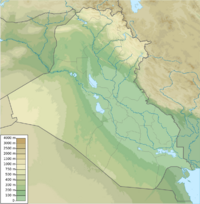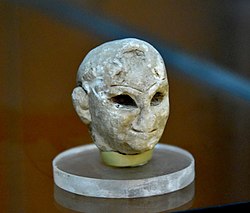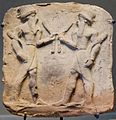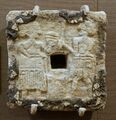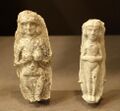History:Eshnunna
| Alternative name | Tell Asmar |
|---|---|
| Location | Iraq |
| Coordinates | [ ⚑ ] : 33°29′3″N 44°43′42″E / 33.48417°N 44.72833°E |
| Type | settlement |
| History | |
| Founded | Late 4th Millennium BC |
| Periods | Bronze Age |
| Cultures | Early Dynastic, Akkadian, Ur III, Isin-Larsa, Old Babylonian |
| Site notes | |
| Excavation dates | 1930 to 1936, late 1990s |
| Archaeologists | Henri Frankfort, Seton Lloyd, Thorkild Jacobsen |
| Condition | Ruined |
| Ownership | Public |
| Public access | Yes |
Eshnunna (modern Tell Asmar in Diyala Governorate, Iraq) was an ancient Sumerian (and later Akkadian) city and city-state in central Mesopotamia 12.6 miles northwest of Tell Agrab and 15 miles northwest of Tell Ishchali. Although situated in the Diyala Valley northwest of Sumer proper, the city nonetheless belonged securely within the Sumerian cultural milieu. It is sometimes, in archaeological papers, called Ashnunnak or Tuplias.
The tutelary deity of the city was Tishpak (Tišpak) though other gods, including Sin, Adad, and Inanna of Kititum were also worshiped there. The personal goddesses of the rulers were Belet-Šuḫnir and Belet-Terraban.
History
Early Bronze
Inhabited since the Jemdet Nasr period, around 3000 BC, Eshnunna was a major city during the Early Dynastic period of Mesopotamia. It is known, from cuneiform records and excavations, that the city was occupied in the Akkadian period though its extent was noticeably less than it reached in Ur III times.[1] Areas of the Northern Palace date to this period and show some of the earliest examples of widespread sewage disposal engineering including toilets in private homes.[2]
The first known rulers of the city were a series of vassal governors under the Third dynasty of Ur. Eshnunna may have had special relationships to the royal family. For example, Shulgi's wife Shulgi-Simtum showed devotion to two goddesses closely connected with the governor's dynasty at Eshnunna, and Shu-Sin's uncle Babati temporarily lived in Eshnunna.[3]
Ituria, the governor of Eshnunna, erected a temple to Shu-Sin in a new lower town. Soon after Shu-Sin's death, Ituria was followed by his son Shu-iliya, who in 2026 BCE got rid of the Ur III calendar and replaced it with a local one.[3][4][5] He also stopped calling himself the ensi (governor) of Eshnunna, instead referring to himself as lugal (king) and "beloved of Tishpak".[3][6] His personal seal shows him facing the god Tishpak, who is holding a rod and ring in one hand and an axe in the other while standing on two subdued enemies.[6] Rulers of Eshnunna after Shu-iliya would call themselves the steward of Eshnunna on behalf of Tishpak, and Tishpak even took on traditional titles usually attested by kings.[7] Bilalama formed a diplomatic marriage with Elam, giving his daughter Me-Kubi to Tan-Ruhuratir.[6]
Middle Bronze
After the fall of the Ur III empire there was a period of chaos in Akkad with numerous city-states vying for power. For a time Eshnunna was under the control of Subartu. Ishbi-Erra (in his 9th year, circa 2010 BC) of the southern Mesopotamia city of Isin defeated them and installed Nurahum as the new king of Eshnunna.[3] Ipiq-Adad II's reign marked the rise of Eshnunna to a world power. He revived the title of king and deified himself by writing his name with a divine determinative.[8]
About the time of the middle 19th century BC Babylon, under Sumu-la-El, and Eshnunna, under Ipiq-adad II, rose to fill the void. The boundary of control between the two city-states was fluid running somewhere about Sippar-Amnanum (now Tell ed-Der). Apil-Sin strengthened territorial acquisitions and extended Babylon's zone of control to the banks of the Tigris, however Naram-Sin of Eshnunna reversed some of these territorial gains.[9][10] Naram-Sin was also the one that forced Shamshi-Adad I into exile.[11]
Dadusha, king of Eshnunna, launched a offense against Shamshi-Adad I. However, Shamshi-Adad launched a counter-offense and the resulting military stand off was concluded with a peace treaty in 1782 BCE.[12][10] Dadusha then collaborated with Shamshi-Adad in a military campaign against Qabra[12][8]
After the death of Shamshi-Adad, his kingdom disintegrated and the conquered kingdoms regained independence. Zimri-Lim, with the help of the king of Aleppo Yarim-Lim, deposed Yasmah-Addu and took the throne of Mari. Ibal-pi-el II tried to impose an alliance with Zimri-Lim of Mari with Eshnunna in the dominant position. However, relations soon broke down and Zimri-Lim was soon openly collaborating with Hammurabi.[13]
Ibal-pi-El also captured Rapiqum and proceeded along the Suhum,[10] and also launched an offense towards the north, occupying Assur, Ekallatum and Qattara before proceeding to capture Shubat-Enlil. Ishme-Dagan I abandoned Ekallatum and took refuge in Babylon.[11]
By then the geopolitical situation had grown very complicated, as shown by a record found at Mari in Zimri-Lim's sixth year (Zimri-Lim's Mari is likely not mentioned because it is taken for granted):
"No king is truly powerful just on his own: ten to fifteen kings follow Hammurabi of Babylon, as many follow Rim-Sin of Larsa, as many follow Ibal-pi-El of Eshnunna, and as many follow Amut-pi-El of Qatna; but twenty kings follow Yarim-Lim of Yamhad"[14]
However, less than eight years later, Eshnunna would lose their status as a great power.[15] The Elamite ruler Siwe-Palar-Khuppak launched an offense against Eshnunna, which was supported by Zimri-Lim and Hammurabi.[10][16] However, the sukkalmah had further ambitions and conquered multiple other cities and even pitted Babylon and Larsa against each other.[17] Eventually Elam's ambitions would be put to an end by a coalition lead by Hammurabi. Eshnunna was looted by the retreating Elamite troops, and the military of Eshnunna installed Silli-Sin, a commoner who used to be a section leader as king despite the presence of a pro-Babylonian faction (ARM 26 377).[18]
Silli-Sin negotiated a treaty with Hammurabi and married one of his daughters to the king of Babylon, then diplomatic relationships with Eshnunna and Babylon worsened. Ishme-Dagan, now back on the throne in Ekallatum, received help from Silli-Sin after Hammurabi denied his request, although Ishme-Dagan would later go back to seek refuge in Babylon again.[11][10] Zimri-Lim, now wary of Hammurabi, supported Silli-Sin in his war against Hammurabi.[10]
In 1762 BC, in Year 31 of Hammurabi of Babylon, the Babylonians occupied the city of Eshnunna. He returned the titular deity of Assur which had been removed when Eshnunna captured the city of Assur.[19]
In his 38th year name, Hammurabi would claim to have destroyed Eshnunna with a flood.[20]
Late Bronze
In the 12th century BC the Elamite ruler Shutruk-Nakhunte conquered Eshnunna and carried back a number of statues, ranging from the Akkadian period to the Old Babylonian period, to Susa.[21][22]
Because of its promise of control over lucrative trade routes, Eshnunna could function somewhat as a gateway between Mesopotamian and Elamite culture. The trade routes gave it access to many exotic, sought-after goods such as horses from the north, copper, tin, and other metals and precious stones. In a grave in Eshnunna, a pendant made of copal from Zanzibar was found.[23] A small number of seals and beads from the Indus Valley civilization were also found.[24]
Archaeology
The remains of the ancient city are now preserved in the tell, or archaeological settlement mound, of Tell Asmar, some 50 miles northeast of Baghdad and 15 km in a straight line east of Baqubah. It was first located by Henri Pognon in 1892 but he neglected to report the location before he died in 1921.[25] It was refound, after antiquities from the site began to appear in dealers shops in Baghdad, and excavated in six seasons between 1930 and 1936 by an Oriental Institute of the University of Chicago team led by Henri Frankfort with Thorkild Jacobsen, Pinhas Delougaz, Gordon Loud, and Seton Lloyd.[26][27][28][29][30][31] The expedition's field secretary was Mary Chubb.[32]
The primary focuses of the Chicago excavations were the palace and the attached temple (28 meters by 28 meters with 3 meter wide walls) of Su-Sin (termed by the excavators The Palace of the Rulers and The Gimilsin Temple respectively). The palace was built during the time of Ur III ruler Shugi and the Temple by governor Ituria to the deified Ur III ruler Su-Sin during his reign. The palace was partially destroyed during the reign of Bilalama but was eventually fully restored. The remaining excavation efforts were directed to the Abu Temple whose beginnings went back to the Early Dynastic I period and which had undergone a series of major changes over the centuries. A large Southern Building was discovered, believed to be from the time of Ipiq-Adad II, of which only the foundations remained. A number of private houses and a palace from the Akkadian period were also excavated. Much effort was also put into the search for E-sikil, temple of Tishpak, without success. In records written in Sumerian the temple is dedicated to Ninazu while those in Akkadian refer to Tishpak.[5][1]
Despite the length of time since the excavations at Tell Asmar, the work of examining and publishing the remaining finds from that dig continues to this day. [33] These finds include, terracotta figurines, toys, necklaces, cylinder seals, and roughly 200 clay sealings and around 1,750 cuneiform tablets (about 1000 of which came from the palace). Because only inexperienced laborers were available many of the tablets were damaged or broken during the excavation. A project to clean, bake, and catalog all the tablets did not occur until the 1970s.[34] The tablets from the Akkadian period were published in 1961.[35] While most of the Eshnunna tablets are of an administrative nature 58 are letters which are rare in this time period. The letters are written in an early form of the Old Babylonian dialect of the Akkadian language, termed "archaic Old Babylonian". They are roughly in two groups a) earlier primarily from the reigns of Bilalama, Nur-ahum and Kirikiri and b) later primarily from the reigns of Usur-awassu, Ur-Ninmar, and Ipiq-Adad I.[5][36]
In the late 1990s, Iraqi archaeologists worked at Tell Asmar. The results from that excavation have not yet been published.[37][38]
Square Temple of Abu
During the Early Dynastic period, the Abu Temple at Tell Asmar (Eshnunna) went through a number of phases. This included the Early Dynastic Archaic Shrine, Square Temple, and Single-Shrine phases of construction.[39] They, along with sculpture found there, helped form the basis for the three part archaeological separation of the Early Dynastic period into ED I, ED II, and ED III for the ancient Near East.[40] A cache of 12 gypsum temple sculptures, in a geometric style, were found in the Square Temple; these are known as the Tell Asmar Hoard. They are some of the best known examples of ancient Near East sculpture. The group, now split up, show gods, priests and donor worshipers at different sizes, but all in the same highly simplified style. All have greatly enlarged inlaid eyes, but the tallest figure, the main cult image depicting the local god, has enormous eyes that give it a "fierce power".[41][42][43]
Laws of Eshnunna
"If a man begat sons, divorced his wife and married another, that man shall be uprooted from the house and property and may go after whom he loves. His wife (on the other hand) she claims the house."[44]
The Laws of Eshnunna consist of two tablets, found at Shaduppum (Tell Harmal) and a fragment found at Tell Haddad, the ancient Mê-Turan.[45] They were written sometime around the reign of king Dadusha of Eshnunna and appear to not be official copies. When the actual laws were composed is unknown. They are similar to the Code of Hammurabi.[46][47]
Rulers
Rulers from the Early Dynastic period and governors under the Akkadian empire are currently unknown. Eshnunna was ruled by vassal governors under Ur III for a time, then was independent under its own rulers for several centuries, and finally controlled by vassal governors under Babylon after the city's capture by Hammurabi. Rulership is unknown afterwards though the city did survive at least until the 12th century BC.[48]
| Ruler | Proposed reign | Notes |
|---|---|---|
| Urguedinna | ~2247 BC[49] | Governor under Shulgi of the Third Dynasty of Ur |
| Bamu | Governor under Shulgi of Ur[50] | |
| Kallamu | Governor under Shulgi of Ur | |
| Lugal-Kuzu | Governor under Shulgi of Ur[51] | |
| Ituria | Governor under Shu-Sin of Ur, known only from Shu-Sin temple dedication | |
| DŠuiliya | Was deified | |
| Nūraḫum | Contemporary of Ishbi-Erra of Isin and Ibbi-Sin of Ur | |
| Kirikiri | ||
| Bilalama | Son of Kirikiri, Daughter ME-ku-bi married Tan-Ruhuratir of Elam | |
| Isharramashu | ||
| Uṣurawassu | ||
| Azuzum | ||
| Urninmarki | ||
| Urningišzida | ||
| Ipiq-Adad I | Contemporary of Abdi-Erah of Tutub and Sumu-abum of Babylon | |
| Belakum | ||
| Sarrija | ||
| Warassa | ||
| Ibal-pi-El I | Recorded building a throne "inlaid with gold and Meluhha pearls" | |
| DIpiq-Adad II | ~1700 BC | Reigned at least 36 years, In his 4th year he defeated the Elamites, First ruler to call himself King, Deified |
| DNaram-Sin | Son of Ipiq-Adad II, Contemporary of Shamshi-Adad I, Deified | |
| Dannum-tāhaz | Approximate position | |
| Dadusha | Son of Ipiq-Adad II, Contemporary of Shamshi-Adad I[52] | |
| Ibal-pi-El II | Contemporary of Zimri-Lim (c. 1775–1761 BC) of Mari, Killed by Siwe-Palar-Khuppak of Elam who captured Eshnunna, in 5th year of reign Shamshi-Adad I dies, son of Dadusha | |
| Silli-Sin | Treaty with Hammurabi (c. 1792 – c. 1750), in year 4 of reign married daughter of Hammurabi[20] | |
| Iluni | Vassal under Babylon, contemporary of Samsu-iluna |
Excavation photographs
See also
- List of cities of the ancient Near East
- Khafajah
- Tell Ishchali
- Chronology of the ancient Near East
- Mari
- Andarig
References
- ↑ 1.0 1.1 [1] Thorkild Jacobsen, "Philological Notes on Eshnunna and Its Inscriptions", Assyriological Studies 6, Chicago: University of Chicago Press, 1934
- ↑ George, A. R. "On Babylonian Lavatories and Sewers.", Iraq, vol. 77, 2015, pp. 75–106
- ↑ 3.0 3.1 3.2 3.3 [2] Reichel, C. 2008. "The King is Dead, Long Live the King: The Last Days of the Šu-Sîn Cult at Ešnunna and its Aftermath.", In: N. Brisch (ed.), Religion and Power. Divine Kingship in the Ancient World and Beyond, 133-155. OIS 4, Chicago.
- ↑ Frankfort, Henri (1948) (in en). Kingship and the Gods: A Study of Ancient Near Eastern Religion as the Integration of Society and Nature. University of Chicago Press. ISBN 978-0-226-26011-2. https://books.google.com/books?id=W-qFZcuGoqUC&q=Ituria+Eshnunna&pg=PA302.
- ↑ 5.0 5.1 5.2 Reichel, Clemens. "Centre and Periphery–The Role of the ‘Palace of the Rulers’ at Tell Asmar in the History of Ešnunna (2,100–1,750 BCE)." Journal of the Canadian Society for Mesopotamian Studies 11 (2018): 29-53
- ↑ 6.0 6.1 6.2 Peyronel, Luca (2013-01-01), "Elam and Eshnunna: Historical and Archaeological Interrelations during the Old Babylonian Period" (in en), Susa and Elam. Archaeological, Philological, Historical and Geographical Perspectives (Brill): pp. 51–70, doi:10.1163/9789004207417_005, ISBN 978-90-04-20741-7, https://brill.com/display/book/edcoll/9789004207417/B9789004207417_005.xml, retrieved 2023-08-15
- ↑ "3. The Origins of Assyrian Cultural Tradition", Religion and Ideology in Assyria (DE GRUYTER): pp. 93–144, 2015-09-25, doi:10.1515/9781614514268-005, ISBN 9781614514824, http://dx.doi.org/10.1515/9781614514268-005, retrieved 2023-08-15
- ↑ 8.0 8.1 Suter, Claudia E. (2018). "The Victory Stele of Dadusha of Eshnunna: A New Look at its Unusual Culminating Scene". Ash-Sharq: Bulletin of the Ancient Near East Archaeological, Historical and Societal Studies 2 (2): 1–30. https://archaeopresspublishing.com/ojs/index.php/ash-sharq/article/view/723.
- ↑ Van Koppen, Frans, and Denis Lacambre. "Sippar and the Frontier between Ešnunna and Babylon. New Sources for the History of Ešnunna in the Old Babylonian Period." Jaarbericht van het Vooraziatisch-Egyptisch Genootschap Ex Oriente Lux 41 (2009): pp. 151-177
- ↑ 10.0 10.1 10.2 10.3 10.4 10.5 Beaulieu, Paul-Alain (2017). A History of Babylon: 2200 BC–AD 75. Wiley Blackwell. pp. 75. ISBN 9781405188999.
- ↑ 11.0 11.1 11.2 Veenhof, Klaas R. (2017-04-07). "The Old Assyrian Period (20th–18th Century<scp>bce</scp>)". A Companion to Assyria: 57–79. doi:10.1002/9781118325216.ch3. http://dx.doi.org/10.1002/9781118325216.ch3.
- ↑ 12.0 12.1 Jordi Vidal. "‘Kill Them All!’ Some Remarks on the Annihilation of the Ya’ilanum Tribe (1781 B.C.E.)." Journal of the American Oriental Society, vol. 133, no. 4, 2013, pp. 683–89
- ↑ Guichard, Michaël (2002). "Les Relations Diplomatiques Entre Ibal-Pi-El Ii Et Zimri-Lim: Deux Étapes Vers La Discorde". Revue d'Assyriologie et d'archéologie orientale 96 (2): 109–142. doi:10.3917/assy.096.0109. ISSN 0373-6032. https://www.jstor.org/stable/23281220.
- ↑ Sasson, Jack M. “The King and I a Mari King in Changing Perceptions." Journal of the American Oriental Society, vol. 118, no. 4, 1998, pp. 453–70
- ↑ "Kingship", From the Mari Archives (Penn State University Press): pp. 21–118, 2015-07-09, doi:10.5325/j.ctv1bxgxg3.5, ISBN 9781575063768, http://dx.doi.org/10.5325/j.ctv1bxgxg3.5, retrieved 2023-08-15
- ↑ Beaulieu, Paul-Alain (2004). Hammurabi King of Babylon: a Biography. Wiley-Blackwell. pp. 16–17. ISBN 978-1-405-12660-1.
- ↑ "Warfare", From the Mari Archives (Penn State University Press): pp. 181–214, 2015-07-09, doi:10.5325/j.ctv1bxgxg3.7, ISBN 9781575063768, http://dx.doi.org/10.5325/j.ctv1bxgxg3.7, retrieved 2023-08-15
- ↑ "Culture", From the Mari Archives (Penn State University Press): pp. 294–342, 2015-07-09, doi:10.5325/j.ctv1bxgxg3.10, ISBN 9781575063768, http://dx.doi.org/10.5325/j.ctv1bxgxg3.10, retrieved 2023-08-15
- ↑ Richardson, Seth. "Axes Against Ešnunna." Orientalia, vol. 74, no. 1, 2005, pp. 42–50
- ↑ 20.0 20.1 Matthew Rutz, and Piotr Michalowski. "The Flooding of Ešnunna, the Fall of Mari: Hammurabi’s Deeds in Babylonian Literature and History." Journal of Cuneiform Studies, vol. 68, 2016, pp. 15–43
- ↑ Blocher, Felix. "Thoughts about the Audience-Hall of Naramsin at Tell Asmar-Ešnunna." Over the Mountains and Far Away: Studies in Near Eastern history and archaeology presented to Mirjo Salvini on the occasion of his 80th birthday, pp. 90-97, 2019
- ↑ Harper, Prudence; Aruz, Joan; Tallon, Frangoise (1993). The Royal City of Susa: Ancient Near Eastern Treasures in the Louvre. New York: The Metropolitan Museum of Art. https://archive.org/stream/RoyalCityofSusaAncientNearEasternTreasuresintheLouvre/RoyalCityofSusaAncientNearEasternTreasuresintheLouvre_djvu.txt.
- ↑ Carol Meyer et al., "From Zanzibar to Zagros: A Copal Pendant from Eshnunna," Journal of Near Eastern Studies, vol. 50, no. 4, pp. 289–298, 1991
- ↑ Henri Frankfort, "The Indus civilization and the Near East." Annual Bibliography of Indian Archaeology for 1932, Leyden, VI, pp. 1–12, 1934
- ↑ J. B. Istas editor, "Le Muséon", Volume 11, Société des lettres et des sciences (Louvain, Belgium), 1892
- ↑ [3] Henri Frankfort, Thorkild Jacobsen, and Conrad Preusser, "Tell Asmar and Khafaje: The First Season's Work in Eshnunna 1930/31", Oriental Institute Communication 13, 1932
- ↑ [4] Henri Frankfort, "Tell Asmar, Khafaje and Khorsabad: Second Preliminary Report of the Iraq Expedition", Oriental Institute Communication 16, 1933
- ↑ [5] Henri Frankfort, "Iraq Excavations of the Oriental Institute 1932/33": Third Preliminary Report of the Iraq Expedition, Oriental Institute Communication 17, 1934
- ↑ [6] Henri Frankfort with a chapter by Thorkild Jacobsen, "Oriental Institute Discoveries in Iraq, 1933/34: Fourth Preliminary Report of the Iraq Expedition", Oriental Institute Communication 19, 1935
- ↑ [7] Henri Frankfort, "Progress of the Work of the Oriental Institute in Iraq, 1934/35: Fifth Preliminary Report of the Iraq Expedition'", Oriental Institute Communication 20, 1936
- ↑ [8] Henri Frankfort, Seton Lloyd, and Thorkild Jacobsen with a chapter by Günter Martiny, "The Gimilsin Temple and the Palace of the Rulers at Tell Asmar", Oriental Institute Publication 43, 1940
- ↑ Chubb, Mary (7 November 1961). "Rebuilding The Tower Of Babel". The Times (55232).
- ↑ [9] Lise A. Truex, "3 Households and Institutions: A Late 3rd Millennium BCE Neighborhood at Tell Asmar", Iraq (Ancient Eshnunna), Special Issue: Excavating Neighborhoods: A Cross‐Cultural Exploration, American Anthropological Association, vol. 30, iss. 1, July 2019
- ↑ [10] "Clay Sealings And Tablets From Tell Asmar", The Oriental Institute News and Notes, no. 159, pp. 1-5, Oriental Institute of Chicago, Fall 1998
- ↑ [11] I.J. Gelb, "Sargonic Texts from the Diyala Region", Materials for the Assyrian Dictionary, vol. 1, Chicago, 1961
- ↑ [12] R. M. Whiting Jr., "Old Babylonian Letters from Tell Asmar", Assyriological Studies 22, Oriental Institute, 1987
- ↑ "Rescuing Iraqi Archeological Reports". http://www.taarii.org/projects/rescuing-iraqi-archeological-reports.
- ↑ Rumaidhy, S., et al. "Iraqi Excavations in the Diyala Region: Tell Asmar (Eshnunna) and Tell Muqtadiya." (forthcoming)
- ↑ [13] Evans, Jean M. "A Reconsideration of the So-Called Single-Shrine Temple at Tell Asmar." in From Sherds to Landscapes: Studies on the Ancient Near East in Honor of McGuire Gibson 71 (2021): 91-105
- ↑ "The Square Temple at Tell Asmar and the Construction of Early Dynastic Mesopotamia ca. 2900-2350 B.C.E", Jean M Evans, American Journal of Archaeology, Boston, Oct 2007, Vol. 111, Iss. 4; pg. 599
- ↑ Frankfort, Henri, "The Art and Architecture of the Ancient Orient", Pelican History of Art, 4th ed 1970, pp. 46-49, Penguin (now Yale History of Art), ISBN:0140561072; the group are now divided between the Metropolitan Museum, New York, Oriental Institute, Chicago, and the National Museum of Iraq (with the god).
- ↑ [14] Henri Frankfort, "Sculpture of the Third Millennium B.C. from Tell Asmar and Khafajah, Oriental Institute Publication 44, 1939"
- ↑ [15] Henri Frankfort, "More Sculpture from the Diyala Region", Oriental Institute Publications 60, Chicago: The University of Chicago Press, 1943
- ↑ Falkowitz, Robert S. "Paragraph 59 of the ‘Laws of Ešnunna.’" Revue d’Assyriologie et d’archéologie Orientale, vol. 72, no. 1, 1978, pp. 79–80
- ↑ [16]Al-Rawi, F. N. H., "Assault and Battery", Sumer, vol. 38, pp. 117–120, 1982
- ↑ The Laws of Eshnunna, Reuven Yaron, BRILL, 1988, ISBN:90-04-08534-3
- ↑ Rosen, Bruce L. "Some Notes on Eshnunna Laws 20 and 21 and a Legal Reform in the Laws of Hammurapi." Revue d’Assyriologie et d’archéologie Orientale, vol. 71, no. 1, 1977, pp. 35–38
- ↑ Maria deJong Ellis, "Notes on the Chronology of the Later Eshnunna Dynasty", Journal of Cuneiform Studies, vol. 37, no. 1, pp. 61–85, 1985
- ↑ Martin, Richard. Discoveries in Anatolia, 1930-31.
- ↑ Michalowski, Piotr. "Chapter 6. The Royal Letters in Their Historical Setting 2: Great Walls, Amorites, and Military History: The Puzur-Šulgi and Šarrum-bani Correspondence (Letters 13–14 and 19–20)". The Correspondence of the Kings of Ur: An Epistolary History of an Ancient Mesopotamian Kingdom, University Park, USA: Penn State University Press, 2021, pp. 122-16
- ↑ Allred, Lance. "The Tenure of Provincial Governors: Some Observations". From the 21st Century B.C. to the 21st Century A.D.: Proceedings of the International Conference on Neo-Sumerian Studies Held in Madrid, 22–24 July 2010, edited by Steven J. Garfinkle and Manuel Molina, University Park, USA: Penn State University Press, 2021, pp. 115-124
- ↑ Bloch, Yigal. "The Conquest Eponyms of Šamšī-Adad I and the Kaneš Eponym List." Journal of Near Eastern Studies, vol. 73, no. 2, 2014, pp. 191–210
Sources
- Chubb, Mary (1999). City In the Sand (2nd ed.). Libri. ISBN 1-901965-02-3.
- Civil, M., “A School Exercise from Tell Asmar”. Studia Orientalia Electronica, vol. 46, pp. 39–42, Apr. 2015
- Reichel C. 2003, A Modern Crime and an Ancient Mystery: The Seal of Bilalama, in: Selz G. J. (ed.), Festschrift für Burkhart Kienast zu seinem 70. Geburtstage dargebracht von Freunden, Schülern und Kollegen, Alter Orient und Altes Testament 274, Münster, pp. 355–389.
- [17] Pinhas Delougaz, "Pottery from the Diyala Region", Oriental Institute Publications 63, Chicago: The University of Chicago Press, 1952, ISBN:0-226-14233-7
- [18] Pinhas Delougaz, Harold D. Hill, and Seton Lloyd, "Private Houses and Graves in the Diyala Region", Oriental Institute Publications 88, Chicago: The University of Chicago Press, 1967
- [19] Pinhas Delougaz and Seton Lloyd with chapters by Henri Frankfort and Thorkild Jacobsen, "Pre-Sargonid Temples in the Diyala Region", Oriental Institute Publications 58, Chicago: The University of Chicago Press, 1942
- I. J. Gelb, "A Tablet of Unusual Type from Tell Asmar", Journal of Near Eastern Studies, vol. 1, no. 2, pp. 219–226, 1942
- Gentili, Paolo. “CHOGHA GAVANEH: AN OUTPOST OF EŠNUNNA ON THE ZAGROS MOUNTAINS?” Egitto e Vicino Oriente, vol. 35, 2012, pp. 165–73
- [20] Max Hilzheimer, translated by Adolph A. Brux, "Animal Remains from Tell Asmar", Studies in Ancient Oriental Civilization 20, Chicago: The University of Chicago Press, 1941
- Lambert, W. G. “Narām-Sîn of Ešnunna or Akkad?” Journal of the American Oriental Society, vol. 106, no. 4, 1986, pp. 793–95
- Romano, Licia, "Who was Worshipped in the Abu Temple at Tell Asmar?", KASKAL 7, pp. 51–65, 2010
- Gary A. Rendsburg, "UT 68 and the Tell Asmar Seal", Orientalia, NOVA SERIES, vol. 53, no. 4, pp. 448–452, 1984
- Claudia E. Suter, "The Victory Stele of Dadusha of Eshnunna: A New Look at its Unusual Culminating Scene", Ash-sharq Bulletin of the Ancient Near East Archaeological, Historical and Societal Studies, vol. 2, no. 2, pp. 1–29, 2018
- Tetlow, Elisabeth Meier (2004-12-28) (in en). Women, Crime and Punishment in Ancient Law and Society: Volume 1: The Ancient Near East. A&C Black. ISBN 978-0-8264-1628-5. https://books.google.com/books?id=ONkJ_Rj1SS8C&q=Eshnunna&pg=PA48.
- R. M. Whiting Jr., "An Old Babylonian Incantation from Tell Asmar", Zeitschrift für Assyriologie, vol. 75, pp. 179 – 187, 1985
- R. M. Whiting Jr., "Four seal impressions from Tell Asmar", Archiv für Orientforschung, vol. 34, pp. 30 – 35, 1987
External links
- The Diyala Project at the University of Chicago
- Tell Asmar Statue at the Oriental Institute of the University of Chicago
 |
